All guns are not created the same way, and neither are their barrels. There are numerous features to barrels, whether they’re for handguns or rifles; everything from rifling to metals used varies. One of the common types of barrels you are likely to hear mentioned is the bull barrel. The bull barrel is a design with a specific shape that’s meant for certain applications. To learn more about bull barrels, how they work, and why they’re necessary, read on.
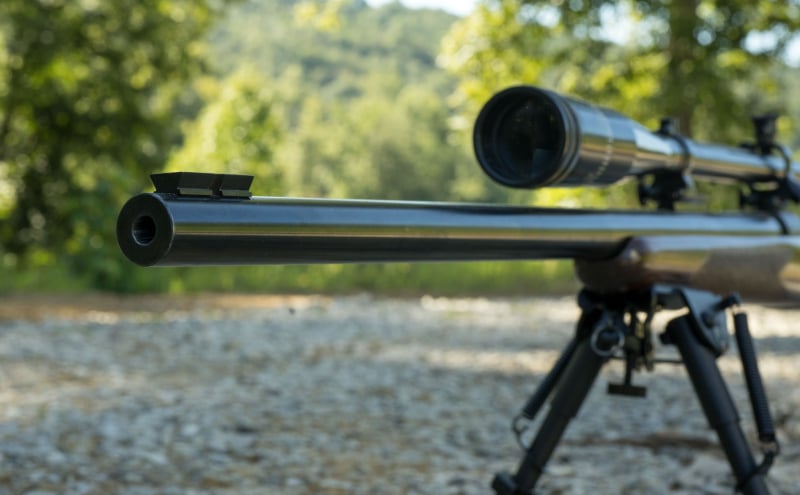
Contents
What is a bull barrel?
What does a bull barrel do?
Who invented bull barrels?
Are bull barrels good?
Can you hunt with a bull barrel?
Is a bushing barrel or bull barrel 1911 better?
What kind of metal are bull barrels made from?
What kind of guns have bull barrels?
What calibers do bull barrels come in?
Who makes 1911 bull barrels?
Who makes rifle bull barrels?
Are these barrels good for self-defense?
What is the purpose of a bull barrel?
Are all bull barrels the same?
What features do bull barrels have?
Frequently Asked Questions
What is a bull barrel?
Generally speaking, bull barrels are heavy barrels. That’s an oversimplification of what they are, but it’s a good place to start. Sometimes that means the barrel doesn’t taper. Other times it means not only does it not taper, it flares out, getting wider toward the muzzle. These barrels are thicker and heavier than what might be considered a standard for that firearm platform.
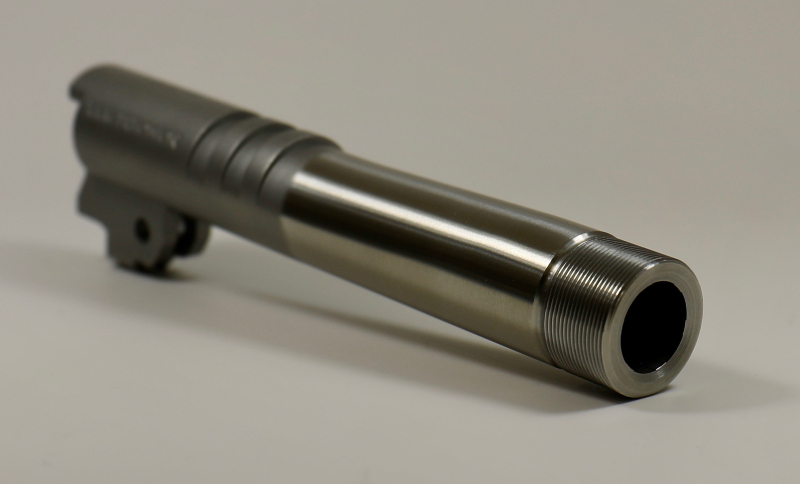
What does a bull barrel do?
Although it might seem logical to believe bull barrels always do the same thing, it isn’t precisely true. They’re used on rifles for many reasons, including improved accuracy, because they resist the expansion from the heat that takes place with lighter-weight barrels (such as pencil barrels). A rifle with a bull barrel can be fired at greater length without excessive heat negatively impacting accuracy.
In addition, heavier barrels produce less vibration during live fire than a skinnier barrel will, which can also make the gun more accurate. Of course, these benefits come at the cost of a heavier gun overall.

On pistols, bull barrels are also heavier, and they reduce muzzle rise during live fire. Their overall bulk also affects how the gun cycles, which can be of significant importance in larger calibers such as 10mm Auto. Bull barrels on pistols are also frequently flared toward the muzzle, meaning they’re visibly bulker at one end than the other. Just as with rifles, this type of barrel can improve accuracy and overall performance in a pistol.
Who invented bull barrels?
The evolutionary steps of barrels aren’t backed by much record-keeping. What is known is that barrels themselves can be traced back to China in around AD 1000. Sometime around the 10th century, the Chinese began using “fire lances” which you could technically say had barrels.
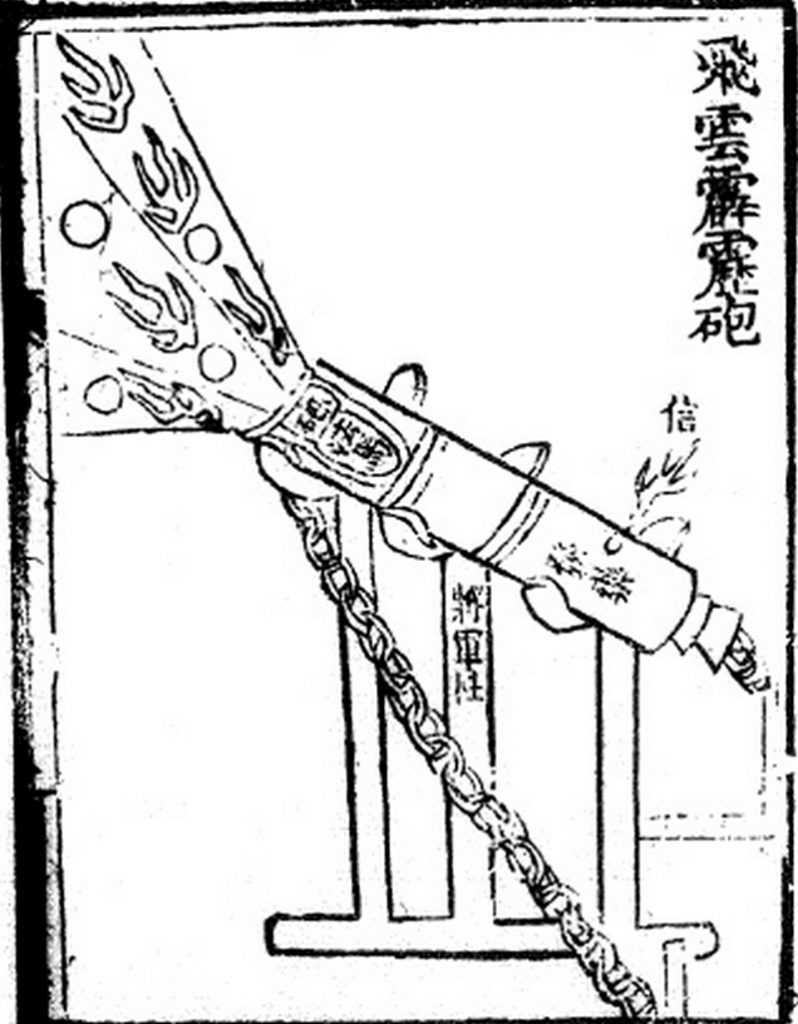
Although not recognizable by modern standards, the fire lance did feature a hollow tube—usually hollowed out bamboo—filled with gunpowder. The tube was attached to a pole, which assisted both in aiming and in keeping the rather risky explosions further from the user, and was limited to single-shot use. Eventually the Chinese began adding projectiles in the form of pebbles and random debris, and by the 13th century, they’d moved on to metal versions of the old bamboo fire lance.
Interestingly, those ancient barrels, such as they were, weren’t even always made of bamboo. According to the book History of Jin, there were some who devised them from layers of paper:
To make the lance, use chi-huang paper, sixteen layers of it for the tube, and make it a bit longer than two feet. Stuff it with willow charcoal, iron fragments, magnet ends, sulfur, white arsenic [probably an error that should mean saltpeter], and other ingredients, and put a fuse to the end. Each troop has hanging on him a little iron pot to keep fire [probably hot coals], and when it’s time to do battle, the flames shoot out the front of the lance more than ten feet, and when the gunpowder is depleted, the tube isn’t destroyed.
What does this have to do with bull barrels? Well, those early steps in firearms technology have a direct correlation to today’s weapons not only because those products are the predecessors of today’s components but because a similar thought process took place in their invention.
For example, it was understood that bamboo was sturdier than paper, but even bamboo was far from ideal. Once metallurgy progressed enough to create tubes, they made the switch to a heavier barrel that could withstand extensive use rather than being good for only one shot. In much the same way, bull barrels are a natural progression of standard barrels because their increased weight and overall design lend them to heavier use and increased accuracy.
You might get one of two replies when asking who came up with the concept of a bull barrel: Philip Webley or Freeman Bull. Webley was a British gunsmith who designed heavy barrels for his revolvers, with his heavier barrel design being traced to around 1876. The Webley Bull Dog, a five-shot pocket revolver, was a popular design that was infamously used to assassinate United States President James Garfield in 1881.

As for Freeman Bull, he was a machinist for Springfield Armory in the late 1800s (yes, right about the same time Webley is credited with inventing the bull barrel). It was 1887 when Springfield made a gun to Freeman’s specifications. The gun in question was a Trapdoor and it had a heavy octagon barrel. Although Freeman enjoyed his gun and encouraged shooters to use heavier barrels for off-hand shooting accuracy, it’s unlikely he was the inventor of the design. It seems likely that honor belongs to Philip Webley.

Are bull barrels good?
Many competitive shooters favor bull barrels because they don’t heat up and lose accuracy as quickly as standard models tend to do. Precision rifle shooters and people who enjoy long-range shooting will rightly mention the benefits of using a gun that’s more solid and capable of greater accuracy—and consistency.
Can you hunt with a bull barrel?
Yes, you can hunt with a bull barrel. Of course, if you’re considering a rifle with a heavier barrel, it might be cumbersome to carry through the woods or mountains. On handguns, bull barrels for hunting can make good sense and they don’t increase carry weight to an extreme.
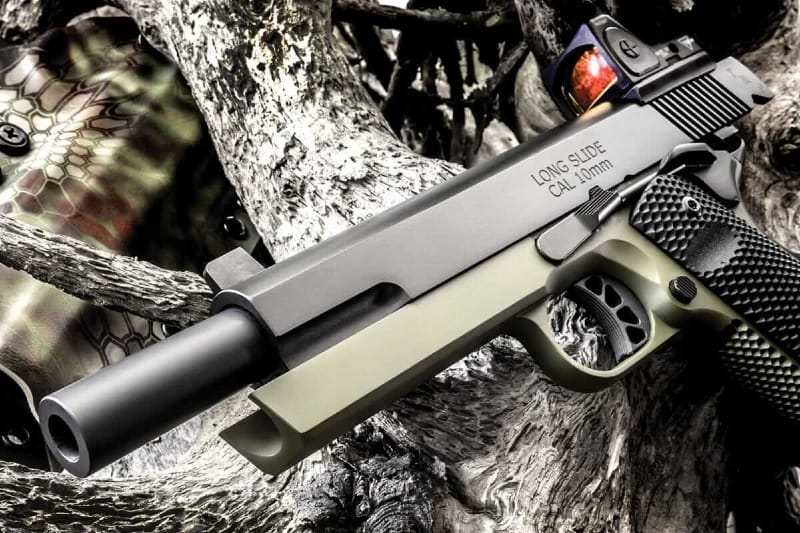
Is a bushing barrel or bull barrel 1911 better?
When 1911s are the topic, most people tend to think of guns with bushings. The bushing on a 1911 is a separate component that fits over the muzzle end of the barrel of the gun. It sits against the side of the gun and helps keep the barrel aligned, among other things. Many 1911 fans will tell you the bushing is a must-have for accuracy, but that isn’t necessarily true. What it really comes down to is how well-made the gun and bushing are, because a bushing with poor fitment can hinder accuracy instead of helping it.
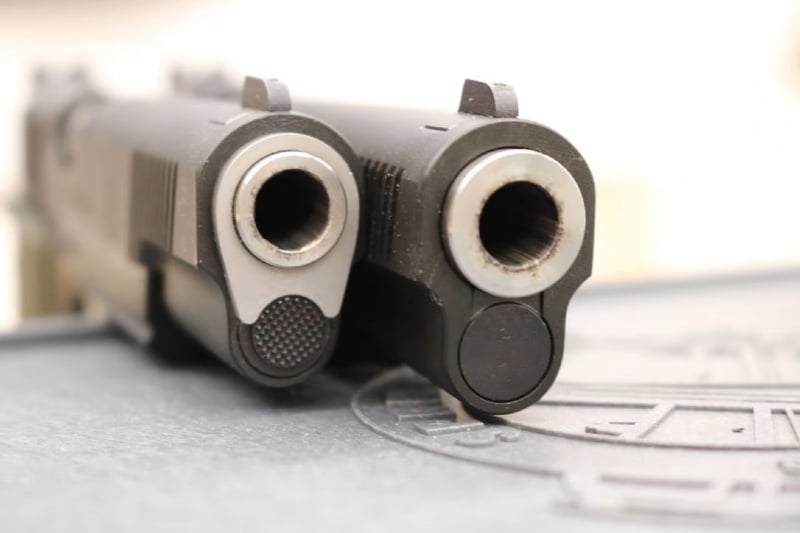
A 1911 with a bull barrel doesn’t have a bushing. Instead, it has a heavy barrel, often one that widens as it nears the muzzle. This is an especially worthwhile part when dealing with bigger caliber 1911s such as those chambered in 10mm Auto. It is possible 1911s with bull barrels wear a bit faster than those with bushing barrels, but that can also be blamed on the typically larger calibers of said barrels.
Which one’s better, bushing or bull barrels? It comes down to the design and quality of the part and gun, the caliber of the gun, and personal preference.
What kind of metal are bull barrels made from?
Like with any barrel, there are numerous options for the metal a bull barrel can be made from. They might be made from any of the following:
- Stainless steel
- Carbon fiber
- Aluminum exterior with steel bore liner
- 416R stainless steel
- Chrome molybdenum steel
- Titanium-cobalt alloys

What kind of guns have bull barrels?
Basically, every platform can be built or bought straight from the factory with a heavy bull barrel. This includes revolvers, 1911s, bolt-action rifles, and more. It’s important to understand that there are heavier barrels marketed for AR-platform rifles that aren’t technically bull barrels, so do your research before selecting one.

What calibers do bull barrels come in?
Although it’s true that larger calibers might benefit most obviously from the use of a bull barrel, they have a stabilizing and accurizing effect on every caliber. There are guns with this style of barrel available chambered in countless cartridges, including:
- 17 HMR
- 22 LR
- 223 Remington
- 224 Valkyrie
- 22-250
- 38 Super
- 56x45mm NATO
- 357 Magnum
- 300 Winchester Magnum
- 308 Winchester
- 40 Smith and Wesson
- 44 Magnum
- 45 ACP
- 5 Creedmoor
- 6 ARC
- 9x19mm Parabellum
- 10mm Auto
Who makes 1911 bull barrels?
There are a lot of options for barrel makers for 1911 platform handguns:
- Briley’s
- Wilson Combat
- Brownells
- Nowlin
- Nighthawk
- Cabot
- KKM Precision
- Jarvis Custom
- Fusion Firearms
- Clark Custom
Who makes rifle bull barrels?

Some of the manufacturers making bull barrels for rifles include:
- CZ USA
- KIDD Innovative Design
- Tanfoglio
- Bullberry Legacy
- Ruger
- Faxon Firearms
- Shilen
- Colt
- Howa
- J. Feddersen
- Criterion
- Luth-AR
- Proof Research
- Volquartsen
- Ballistic Advantage
- LSP
- Beyer Barrels
- Brownells
- Green Mountain
- FightLite Industries
- Krieger Barrels
- Bartlein Barrels
- Sako
- Shaw Barrels

Are these barrels good for self-defense?
For practical purposes, long guns with bull barrels will be less than ideal for defensive purposes. This is due to their overall weight and balance. If you’re trying to aim a rifle off-hand that has a heavy barrel, you’ll have a more difficult time shooting accurately than you would with a lighter-weight firearm.
Handguns with bull barrels are just as good for self-defense as any other handgun might be. The bulk of the heavier barrel isn’t as obvious as on a rifle, and it might lend some accuracy to your shots.
From a realistic stance, having a heavy barrel shouldn’t be something that makes you choose or discount a gun for self-defense use. It’s simply part of a whole and should be considered as such.
What is the purpose of a bull barrel?
These barrels are meant to improve precision. If you spend time shooting rifles with standard or pencil barrels, you’ll discover they heat up quickly. Once they get too hot, accuracy is lost, and it can take some time for them to cool off enough to get back to normal. This has a big impact on things like long-range shooting. If you’re trying to dial in on a thousand-yard target and the barrel heats up within a few shots, it takes a lot longer to get on target than with a heavy barrel.

The harmonics and vibration of bull barrels differ from those of standard barrels. That can also be helpful when doing something like long-range shooting when something that only matters fractionally at closer distances becomes a huge change the further out you go.
Are all bull barrels the same?

You will notice variations in bull barrel designs. Aside from the fact that some are solid steel while others are made from something like aluminum with a steel bore liner, there are other features that might change by manufacturer.
Some bull barrels are fluted in a way that helps reduce some of the heat and weight without having a negative impact on performance. Gun makers might offer this style with a threaded muzzle end or without one. And, of course, length varies.
What features do bull barrels have?
Aside from the obvious feature of having a heavy barrel that does not taper from the receiver to the muzzle, bull barrels can have different features. Here are some examples from a few manufacturers. This is not meant to be an exhaustive list but is a random selection of barrel makers to give you an idea of the possibilities.
Faxon Firearms 6mm ARC bull barrel

Faxon describes the barrel:
Made from 416R stainless steel and finished with a black Nitride finish, these come in a heavy profile with a 1-8 5R twist rate, and 5/8-24 muzzle threads.
Available in four different lengths here are the associated specifications:
- 14.5” length with Carbine length gas system and 0.069” gas port diameter
- 16” length with Mid-Length gas system and 0.079” gas port diameter
- 18” length with Mid-Length gas system and 0.079” gas port diameter
- 20” length with Rifle length gas system and 0.085” gas port diameter
Regardless of what barrel length you choose each barrel follows the same following specs:
- 1-8 5R twist
- .750” gas block diameter
- Heavy profile
- 5/8-24 muzzle threads
- 416R stainless steel
- Black Nitride finish
F.J. Fedderson Ruger 10/22 Bull Rifle Barrel

As described by the company:
The F.J. Feddersen 16-Long-B is a match-grade 16.25-inch bull barrel for the popular Ruger 10/22 Rifle chambered in 22LR. Our 10/22 replacement barrels are milled from 4150V chrome moly vanadium steel using our patented production techniques and decades of gunsmithing experience. FJF rifle barrels have 22 Bentz chamber and are perfect replacements for the original factory gun barrels. Just drop one in for an exact fit and improved accuracy. The 16-Long-B model has a matte black finish for low reflectivity.
Matte Black Finish
Our 10/22 bull barrels look as good as they shoot. Our matte finish for chrome moly vanadium steel is evenly applied with media blasting and blackening technologies that give our matte barrels a low reflectivity with diffused highlights. The coating will provide years of hard-wearing protection and corrosion resistance to your rifle.Compatibility
F.J. Feddersen’s 16.25-inch 10/22 bull barrels compatible with many of Ruger’s 10/22 rifles with .920 profiles. Our drop-in 10/22 barrels slip into your existing receiver (or a new receiver) and interchange easily with the factory barrel.
Proof Research Carbon Fiber Barrels

Regarding their carbon fiber barrels, many of which are offered as a bull barrel, Proof Research says:
Carbon fiber has long been hailed across many industries—aerospace, cycling, alternative energy—as a wonder material making everything lighter and stronger. When employed in a rifle barrel the benefits extend beyond reducing weight and increasing strength. Our patented manufacturing process begins with full-profile, match-grade 416R stainless steel barrel blanks that are made in our firearms division. These blanks are then turned down to a significantly reduced profile greatly reducing weight. This reduced contour barrel is then wrapped with high-strength, aerospace-grade carbon fiber impregnated with a proprietary matrix resin developed by our advanced composites division, PROOF Research ACD. The carbon fibers we use have a unique ability to diffuse heat along the length of the barrel (much like fiber optics transmit light). Carbon fiber also moves heat very effectively through the wall (thickness) of the barrel greatly increasing heat transport resulting in barrels that cool faster, maintain accuracy over longer sessions of fire, and live longer. The end result is an aerospace-grade, high-fiber content composite barrel that is stronger, lighter, as accurate as the finest precision steel barrel, and durable to perform in the most demanding environments. They’re not just lighter—they’re better.
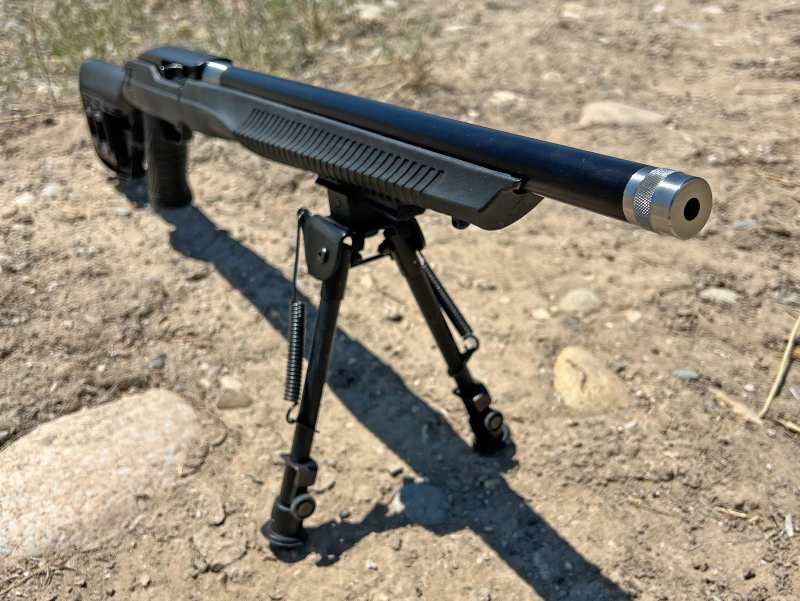
Frequently Asked Questions
Why is a heavier barrel more accurate than a lighter one?
Heavier barrels tend to produce more consistently accurate shots because the weight counters the potentially distorting effects of heat. They also vibrate less, which means there are fewer external influences on the bullet’s path as it exits the gun.
How long do bull barrels last?
The life of any barrel depends on various factors such as overall quality and caliber. In general, a good barrel should last for tens of thousands of rounds. Some barrel makers will say their designs are good for 25,000 rounds while others estimate longevity beyond 100,000 rounds.
Are bull barrels on 1911s better than bushing barrels?
Whether or not your bull or bushing barrel is better on your 1911 comes down to personal preference, overall quality of the firearm, and caliber. There are a lot of precise 1911s out there with both styles of barrels.
Do varmint rifles have bull barrels?
Some rifles built specifically for hunting varmints have bull barrels while others do not. Do research before selecting a gun.
Does a 9mm really need a bull barrel?
Many 9mm guns that have bull barrels also have short barrels. In those cases, it makes sense for cycling reasons to go with a bull style rather than a bushing.
Are all heavy barrels bull barrels?
Usually, a barrel that’s referred to as a heavy barrel is a bull barrel, but that isn’t always true. This especially applies to AR-platform rifles, because there are a lot of “heavy” barrel designs for ARs that are not technically bull barrels. Remember, a bull barrel does not taper.
Are carbon fiber bull barrels good?
Carbon fiber is a great material for barrels. Not only is it lighter weight, but it’s also capable of delivering greater accuracy than stainless steel designs.

Can a revolver have a bull barrel?
Yes, revolvers can have bull barrels. Not all revolvers have a bull barrel, though. As with other platforms, a bull-barreled revolver has a heavier barrel with no taper.
Are all bull barrels big calibers?
No. In fact, a lot of bull barrels are chambered in diminutive calibers like 17 HMR and 22 LR.
Is it better to have a long or short bull barrel?
Length of barrel depends on what you intend to do with it. Although a longer barrel can help you get every last bit of velocity and energy out of a bullet, there is a point at which the difference becomes negligible (which depends on the caliber). With handguns, barrel length matters, but it might not affect velocity as much as you might believe. That doesn’t mean longer barrels don’t have a lot of benefits, because they do, but only to say a longer barrel is not a guarantee of accuracy or velocity.
Do you have to have a bull barrel for long-range shooting?
No, you don’t have to have a gun with a heavy or bull barrel to be a successful long-range shooter. It can certainly make life easier, but it isn’t a must. If you intend to compete or spend a serious amount of time shooting at significant distances, do consider adding a bull barrel to your gun collection.
What is the downside of using this kind of barrel?
The most obvious negative effect of heavier barrels is their weight. If you’re going to be carrying your long gun much, the weight can wear on you quicker than you might realize. That doesn’t mean it’s impossible to take a bull barreled rifle on a mountain goat hunt, only that the excessive weight is going to be felt.
Do bull barrels cost more?
The cost of a bull barrel depends entirely on the manufacturer and the overall quality of the product. You can find heavy barrels cheaper than standard profile barrels, and vice versa.
Can I put a bull barrel on my rifle?
Whether or not you can put an aftermarket bull barrel on your rifle depends on the frame or receiver of the gun. Not all barrels work with all frames, regardless of them being the same caliber.
Should I get a bull barrel?
If you’re interested in precision or want to be able to shoot your bolt-action for extended periods without the barrel overheating quickly, it’s worth considering a bull barrel. One of the downsides of standard or pencil barrels is that the difference in accuracy between a cold and hot barrel can be astonishing. Using a heavy barrel can correct that, or at least slow down the process because they don’t become excessively hot as fast.

How accurate are bull barrels?
The accuracy of any barrel depends on a few things: The quality of the barrel itself, the ammunition being used, the overall design of the firearm, and the skills of the shooter in question.
Are 1911s with bull barrels easier to shoot than bushing barrel 1911s?
There’s not really any practical difference in shooting a bull or bushing barrel 1911. The 1911 itself remains the same, it’s the barrel that changes. A bushing can be poorly designed or installed so it shifts a bit during use which will negatively impact accuracy, but it can also be well designed and correctly installed in a way that improves shot placement. The quality of the gun and skills of the shooter play a larger role than bull versus bushing barrels.
Do I have to have a bull barrel rifle to shoot a mile?
Although using a rifle with a bull contour barrel can make things easier, it isn’t a must for success with a one-mile shot. Allowing the barrel to cool off as needed, taking your time, and understanding drop and drift are key to making that shot at a mile.
Do Glocks have bull barrels?
No, they do not.
Do air guns have bull barrels?
Yes, there are air guns being made with bull barrels.
What are other names for bull barrels?
Bull barrels are sometimes called bull contour barrels, heavy barrels, heavy bull barrels, and heavy profile barrels.


